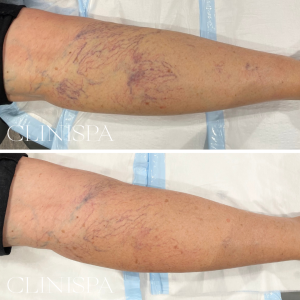Every new patient receives a tailored consultation, treatment plan and clinical photography with a Cosmetic Registered Nurse and Doctor. An assessment is required to assess the treatment area requested, the skin quality and determine the ideal aesthetic outcome, including alternative treatment options.
Once your nurse has cleansed the area to be treated, a prescription numbing cream is applied to reduce any minor discomfort. The solution is injected in small volumes of directly into the vessels to be treated using a very fine needle. The discomfort associated with the procedure can be likened to a stinging sensation sensation as the solution travels through the vein, but this is generally well tolerated. We aim to minimise any discomfort you may experience.
To ensure optimal results, specific aftercare instructions are provided:
- Apply cool packs after your treatment to reduce the initial swelling effects.
- Avoid exercise for 24 hours
- Do not apply makeup for 24 hours
- Avoid alcohol, ibuprofen and fish oil 1 week prior to treatment and 48 hours post treatment
Please inform the medical staff if you take any aspirin or blood thinning medications.
A LED healite treatment can also be added to your treatment to assist in a quick recovery.
Sclerotherapy is a clinical treatment which must be administered in a controlled medical environment under a doctor’s supervision. Dr Guy Watts and his nurses have the highest standards when it comes to your safety.
Our nurses/doctor will discuss all the risks and contraindications during your initial consultation.
There are minimal risks with sclerotherapy, but the most common side effects include temporary bruising and tenderness around the injection site.
Uncommon but potential side effects include:
- Infection at injected site
- Transient hyperpigmentation or light coloured discoloration which can persist for up to 12 months
- Sloughing which consists of small, slowly healing ulcers at the injected site
Contraindications that will need to be disclosed to our nurses include:
- Pregnancy or breastfeeding
- Prior diagnosis of deep vein thrombosis (DVT)
- Active infection at the injection site
- Taking blood thinning medications
- Have preexisting blood conditions



